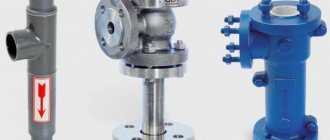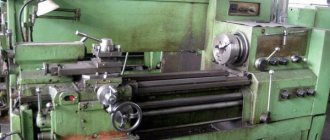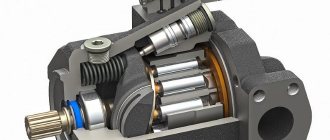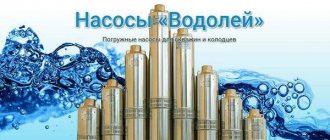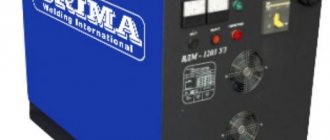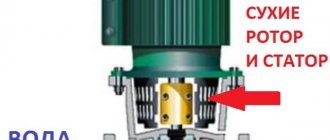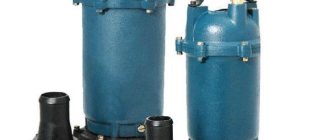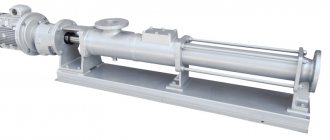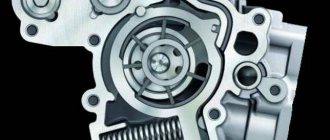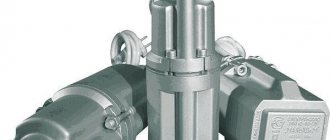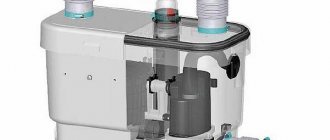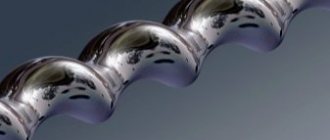- Overall and connecting dimensions of KM type pumps.
KM pumps, in accordance with generally accepted classifications, include:
- by design - cantilever (unlike pumps of type K
, the impeller is located directly on the shaft of a specially designed drive motor or on an intermediate shaft, which is also mounted on the shaft of a conventional flanged or combined mounting type electric motor). - according to the principle of operation - centrifugal, dynamic, bladed, with an output flow at the exit of the radial type impeller (impeller - closed type).
Cantilever monoblock pumps KM
by type of pumped medium, they are designed mainly for water (except sea water) and liquids similar to water in density, viscosity (up to 36 cSt), with a pH value from 6 to 9. KM monoblock pumps for special purposes are also produced:
— for pumping chemically active media (XM pump), — light petroleum products (KMN pump), — food products — other monoblock pumps for various media. Most household pumps are produced in a monoblock design.
Temperature of the pumped liquid for KM water pumps:
- with an stuffing box seal - from 0 to 80 o C, - with a mechanical (end) seal - from 0 to 105 o C (short-term excess of the maximum temperature up to 120 o C is allowed).
- for pumps with gland seal - 3.5 atm. — for pumps with mechanical seal — 6 atm.
KM pumps allow a small amount of mechanical impurities in the pumped liquid: up to 0.2% by weight. Particle size in impurities is up to 0.2 mm. Suction height ( KM pump is not self-priming
) varies depending on the brand of pump. To determine the suction height of the pump (when pumping water from an open source, at normal atmospheric pressure, at a water temperature of 20 o C), you can use a simplified formula
Cantilever monoblock pumps are devices with a centrifugal design; their type is single-stage monoblock; the nature of the supply of the working liquid mass is unidirectional. The scope of application of these pumps is water supply, circulation processes and heating systems. They are used for pumping water and liquids similar to it in physical properties.
This includes clean, drinking water, industrial water for use in production, the pH should be from 6 to 9. The exception is sea water. Pumps can also pump other liquids that are close to water in density, viscosity and chemical activity. Solid inclusions should not exceed 0.2 mm, the concentration per unit volume should be up to 0.1%.
The temperature regime of the working fluid for devices such as cantilever monoblock pumps is from 0 to 850C (with a single gland seal) or up to 1050C (if the mechanical seal is single). Cantilever monoblock pumps are not allowed for use in industries with explosion and fire hazards, as well as for pumping flammable liquids. The following materials are used in the pumps: the flow part is made of gray cast iron, the shaft end seal is a single stuffing box.
Design of a cantilever monoblock pump
The equipment of such equipment as cantilever monoblock pumps, by analogy with cantilever pumps, has a centrifugal wheel, a pipe for receiving and discharging liquid mass, a spiral-ring outlet, a housing, and clamps. The impeller is made in the form of two disks with curved blades between them. Cantilever monoblock pumps and cantilever pumps have differences in weight and size and, in addition, in the design of connections to the electric motor.
In cantilever monoblock pumps, an extended shaft in the motors is used for drive. The impeller is attached to the end of this shaft. This connection method is more reliable due to the smaller number of bearing units.
The design of mechanisms such as cantilever monoblock pumps consists of a volute casing with axial suction and radial discharge pipes, the angle between them is 900. The impeller is mounted on the electric motor shaft. The pump housing and the electric motor are connected by a drive lantern; an O-ring is located between the lantern and the pump housing. A coupling is attached to the center of the lantern. The design of the pump allows for the removal of the electric motor and impeller without dismantling the pump housing. Both the pump and the electric motor are mounted on the same steel frame.
Where is it used?
Excellent technical and other characteristics have made such devices as cantilever monoblock pumps incredibly popular in the modern market. Thus, the high reliability indicator made it possible to use the units in a wide variety of areas of life. Often we are talking about areas such as:
- agriculture, where pumping clean water is necessary;
- in industry;
- in the food industry;
- in the chemical industry;
- when installing high pressure systems;
- pumping stations;
- cooling systems;
- central water supply;
- heating systems.
Sometimes their main task is only to cool large rooms and workshops. In some cases, only the transportation of water for domestic purposes is necessary, and contact with the working environment is not expected.
Operating principle of a cantilever centrifugal monoblock pump
During the operation of cantilever monoblock pumps, the electric motor transmits torque to the impeller through the shaft. The inlet pipe is filled with liquid, which is forcefully ejected through the outlet pipe with greater pressure and speed compared to the inlet pipe. This process occurs through centrifugal force, which arises from the rotation of the impeller.
When liquid is ejected into the outlet pipe, a vacuum occurs in the center of the wheel, resulting in a pressure difference between the pump inlet and its center. Under the influence of a pressure difference, the product moves from the inlet pipe to the pump housing, where it is again captured by the centrifugal force of the wheel, after which the process of moving the liquid is repeated.
The precision of the technological execution of the design of such equipment as cantilever monoblock pumps allows the use of high-quality technical functioning of the devices over a long period, without the need for replacement or repair.
For cold and hot water - these are units designed for pumping liquid (water); by type of design: horizontal, single-stage, with one-way liquid supply to the impeller located at the end of the pump shaft. In terms of design, technical characteristics, and areas of application, they are centrifugal pumps for water. The main qualities of cantilever monoblock pumps and cantilever pumps are high quality production and long service life, based on the high reliability of these units.
Scope of use. Advantages and disadvantages of equipment
Thanks to the numerous characteristics of such equipment, pumps have found their application in many everyday areas of human activity. Due to the versatility of the design, they became widespread quickly and quite confidently. This type of equipment is used in the construction of water supply, cooling and heating systems. Can also be found at booster stations that are involved in firefighting. If we take into account all the positive aspects of this device, then there are quite a lot of them.
First of all, you should pay attention to such indicators as quality and the widest selection of various parameters. The second thing you should pay attention to is the design of the selected model, which will be incredibly compact. Taking into account the affordable pricing policy, monoblock pumping units have a certain efficiency indicator, which will be 30-80%. This type of equipment cannot be classified as demanding in terms of the quality of the working environment. The temperature of the working environment can exceed 100°C. However, such models are not without drawbacks, which include:
- high requirements for ongoing maintenance, due to the presence of gland-type seals;
- installation work must be carried out on a special frame or prepared foundation;
- The equipment has only one working position – horizontal;
- the vibration and noise indicator is slightly higher than that of models that use a wet rotor;
- The device uses rolling bearings, as well as end-type seals for the shaft.
Purpose of cantilever pumps and cantilever monoblock pumps
Cantilever pumps (type K) and cantilever monoblock pumps (type KM) are single-stage centrifugal pumps with a one-way liquid supply to the impeller. They are designed for pumping water (except seawater) and other liquids similar to water in density, viscosity and chemical activity, temperatures from 0°C to 85°C (on special order up to 105°C), containing solid inclusions up to 0. 2 mm, the volume concentration of which does not exceed 0.1%.
Cantilever pump
Pumps K65 200 and K100 80 160 – design features of the units
K 100 pumps have an almost identical design. They are centrifugal devices operating on the principle of one-way supply of pumped liquid towards the wheel. In these devices, the motor and horizontal pump are located on the same platform.
The wheel of the unit K 100 65 200 is a closed type element. The pump is equipped with an axial liquid supply. Angular contact and radial ball bearings act as rotor support.
In the upper part of the housings of the units there are holes closed with a plug. When the holes are opened, air escapes from the pumps. The lower parts are equipped with holes for draining liquid.
The areas of application for K 100 pumps are quite extensive. The units can be used to pump clean and contaminated water and other liquids with a slightly higher density. Fecal devices have an additional protective coating on the body and main components.
Symbols of cantilever pumps and cantilever monoblock water pumps
TO
— horizontal cantilever pumps with a support on the housing, with rotation transmitted from the engine through an elastic coupling.
KM
,
KMM
- cantilever monoblock (KMM - modernized) pumps. The pump impeller is mounted on the end of an extended electric motor shaft.
Pump symbol according to GOST 22247-96: Consider, for example, the K80-50-200-S-UHL4
.
K
- pump type (cantilever);
80
- nominal diameter of the inlet pipe, mm;
50
— nominal diameter of the outlet pipe, mm;
200
— nominal diameter of the impeller, mm;
C
- symbol of a single gland seal of the pump shaft or
SD
- double gland seal;
UHL
- climatic version;
4
- category of placement of the unit during operation
of a cantilever monoblock pump
Subsequent use
Thanks to the suction pipe, the direction of liquid movement occurs along the axis. Bypassing the pipe, the water ends up in the working area of the wheel, equipped with a certain number of curved blades. Inertial forces contribute to changing the direction of movement - from the central part of the wheel to its edge. This swirling liquid begins to accumulate in the spiral casing, then rushes out of the pump. The shape of the spiral casing is identical to the diffuser. The sequence of processes in such a pump is as follows. If the wheel begins to rotate twice as fast, then the feed increases by the same amount, and, consequently, the pressure force increases four times. As for the consumed electricity, its consumption will increase eightfold.
Operating principle and design of cantilever pumps and cantilever monoblock pumps
The main working part of a cantilever water pump is a centrifugal wheel. A centrifugal wheel consists of a pair of disks with blades located between them, connected into a common structure. The impeller blades have a smooth bend in the direction opposite to the direction of rotation of the impeller. This device is the most common. With such a device, the impeller is called closed. Sometimes you can find cantilever centrifugal pumps with an open impeller design, which in this case consists of a single disk. When the impeller rotates, the liquid inside it is subjected to a centrifugal force directly proportional to the distance of a unit of liquid from the center of the impeller and the square of the angular speed of rotation of the impeller. Under the influence of this centrifugal force, water is pushed out of the impeller into the pressure (outlet) pipe of the cantilever centrifugal pump, and a vacuum occurs in the central part of the impeller, and high pressure occurs in its peripheral part. The flow of liquid from the suction pipeline occurs due to the difference in pressure at the surface of the water in the receiving tank and in the central part of the wheel.
Typically, cantilever centrifugal pumps include single-stage centrifugal pumps, cast iron in construction material, with one-way liquid supply, the impellers of which are located at the end of the electric motor shaft. Other types of industrial pumps, such as sewage, chemical, and soil pumps, also have this type of design.
The design of cantilever and cantilever monoblock pumps at the location of the sealing unit depends on the temperature of the pumped liquid, as well as the pressure in the supply pipe at the inlet to the pump. Barrier fluid is not supplied to the single soft seal. In the double gland seal, at a temperature of the pumped liquid up to 90°C, the barrier liquid is supplied to the dead end, and at a temperature above 90°C - to the flow. The pumped liquid from the pressure pipeline can be supplied to the single mechanical seal. In the double mechanical seal of the cantilever pump, the barrier fluid is supplied only to the flow path. In all cases, the barrier fluid is supplied under pressure exceeding the pressure before compaction by 0.5...1.5 kgf/cm2. Any non-toxic and non-explosive liquid with a temperature not exceeding 40°C, containing particles up to 0.2 mm in size with a volume concentration of up to 0.1%, can be used as a barrier liquid. The maximum permissible excess pressure of the pumped liquid at the inlet: for cantilever water pumps with a gland seal - 3.5 kgf/cm2, for cantilever and cantilever monoblock pumps with a mechanical seal - 8 kgf/cm2.
The maximum permissible external water leakage through the gland seal of a cantilever centrifugal pump is up to 3 l/h (liquid must leak through the gland to lubricate and cool the sealing surface). Leakage through the mechanical seal is significantly less and, ideally, can be close to zero.
Equipment K 20 30 and K 30 30 – areas of application of pumps
The K 20 cantilever centrifugal pump is equipped with an axial supply in a horizontal position. It is used for pumping various liquids, while being located in a horizontal position. The K20 30 shaft is equipped with a single mechanical seal. Models with double gland seals can also be found on sale.
The K 30 30 pump is used in more areas. It is successfully used in industrial pumping stations, heating pipelines, urban and rural water supply. However, this equipment cannot be used in explosive atmospheres.
Among the technical characteristics of the pump of this modification, the following should be highlighted:
- Pressure to a depth of up to 30 m;
- Productivity – maximum 20 m3/h. work;
- Rotation speed – 3 thousand rpm;
- Weight – 78 kg;
- Power – 4000 Watt.
The unit has high build quality, reliability and does not require constant maintenance.
Table of technical characteristics of cantilever pumps and cantilever monoblock pumps.
| Pump name | Supply, m3/h. | Napor, m. | Engine, kW* rpm | d in, mm | d out, mm | Weight, kg | Dimensions, mm. LxBxH |
| K8/18 | 8 | 18 | 2,2*3000 | 40 | 32 | 58 | 764*257*323 |
| K50-32-125 | 12,5 | 20 | 2,2*3000 | 50 | 32 | 58 | 764*257*323 |
| K20/30 | 20 | 30 | 4*3000 | 50 | 40 | 78 | 827*299*332 |
| K65-50-125 | 25 | 20 | 3*3000 | 65 | 50 | 120 | 730*368*325 |
| K65-50-160 | 25 | 32 | 5,5*3000 | 65 | 50 | 140 | 925*408*338 |
| K45/30 | 45 | 30 | 7,5*3000 | 50 | 40 | 126 | 1030*332*413 |
| K80-50-200 | 50 | 50 | 15*3000 | 80 | 50 | 255 | 1120*458*455 |
| K80-50-200a | 45 | 40 | 11*3000 | 80 | 50 | 185 | 990*428*425 |
| K100-80-160 | 100 | 32 | 15*3000 | 100 | 80 | 275 | 1105*458*450 |
| K100-80-160a | 90 | 26 | 11*3000 | 100 | 80 | 200 | 1105*458*450 |
| K100-65-200 | 100 | 50 | 30*3000 | 100 | 65 | 370 | 1290*498*510 |
| K100-65-200a | 90 | 40 | 18,5*3000 | 100 | 65 | 325 | 1265*498*475 |
| K100-65-250 | 100 | 80 | 45*3000 | 100 | 65 | 485 | 1440*568*620 |
| K100-65-250a | 90 | 67 | 37*3000 | 100 | 65 | 460 | 1390*568*605 |
| K160/30 | 160 | 30 | 30*1500 | 150 | 100 | 420 | 1515*515*555 |
| K160/30a | 140 | 28,6 | 22*1500 | 150 | 100 | 400 | 1465*515*555 |
| K160/30b | 140 | 22 | 18,5*1450 | 150 | 100 | 340 | 1495*505*530 |
| K150-125-250 | 200 | 20 | 18,5*1500 | 150 | 125 | 410 | 1325*475*455 |
| K150-125-315 | 200 | 32 | 30*1500 | 150 | 125 | 422 | 1375*540*610 |
| K290/30 | 290 | 30 | 37*1500 | 200 | 150 | 550 | 1645*575*630 |
| K290/30a | 250 | 24 | 30*1500 | 200 | 150 | 460 | 1555*515*585 |
| K200-150-250 | 315 | 20 | 30*1500 | 200 | 150 | 422 | 1375*540*610 |
| K200-150-315 | 315 | 32 | 45*1500 | 200 | 150 | 570 | 1665*600*720 |
| KM50-32-125 | 12,5 | 20 | 2,2*3000 | 50 | 32 | 47 | 500*200*202 |
| KM65-50-160 | 25 | 32 | 5,5*3000 | 65 | 50 | 76 | 578*250*272 |
| KM80-50-200 | 50 | 50 | 15*3000 | 80 | 50 | 90 | 790*350*420 |
| KM80-65-160 | 50 | 32 | 7,5*3000 | 80 | 65 | 90 | 630*320*362 |
| KM100-80-160 | 100 | 32 | 15*3000 | 100 | 80 | 195 | 790*350*420 |
| KM100-65-200 | 100 | 50 | 30*3000 | 100 | 65 | 260 | 865*400*440 |
| KM150-125-250 | 200 | 20 | 18,5*3000 | 150 | 125 | 195 | 870*370*705 |
Our Company offers a full range of industrial and domestic pumps, including cantilever pumps, drainage, self-priming, fecal, irrigation, well and many, many others. You can familiarize yourself with the range and technical characteristics on the website page.
Cantilever monoblock pumps are horizontal single-stage cantilever pumps with a one-way liquid supply to the impeller. These pumps, like conventional cantilever pumps, are designed for pumping clean water (except sea water) under stationary conditions, with pH = 7, temperature from 0 to 85 ° C, containing solid inclusions up to 0.2 mm in size, the volume concentration of which does not exceed 0.1%, as well as other liquids similar to water in density, viscosity and chemical activity. The scope of application is identical to the scope of application of cantilever pumps of type K. The advantage of cantilever monoblock pumps is their compactness compared to cantilever pumps of type K. This advantage makes it possible to install pumps in a limited area. However, there is also a drawback that after turning the impeller it is impossible to select a three-phase electric motor with a lower power. The reason lies in the design of the pump and the monoblock electric motor with an extended shaft specially designed for the pump. Hidden in the cast iron casing of the pump is its main working body - the centrifugal impeller (cast iron grade SCh20 or SCh25). The role of the pump shaft is actually played by the shaft of a three-phase electric motor, since the pump impeller is mounted on the electric motor shaft. There are two main types of shaft seals: single gland seal and single mechanical seal. The stuffing box seals are designated by the letter “C” to the main brand; if it is not there, then it is implied. Leakage through the gland seal is no more than 2 l/h, to lubricate and cool the soft packing. Single mechanical seal - brand index “5”. External leakage through the mechanical seal is no more than 0.03 l/h. Pumps with mechanical seals can pump liquids with temperatures from 0 to 115 ° C. Pressure at the pump inlet is up to 8.0 kgf/cm2.
An example of a pump unit symbol:
KM80-50-200 a-5 UHL4
- KM
- pump type - monoblock console pump, centrifugal - 80
— diameter of the suction inlet pipe, mm, - 50
— diameter of the pressure outlet pipe, mm, - 200
— nominal diameter of the impeller, mm, - a
- first turning of the impeller, - 5
- designation of a single mechanical seal, - UHL4
- climatic version and placement category.
